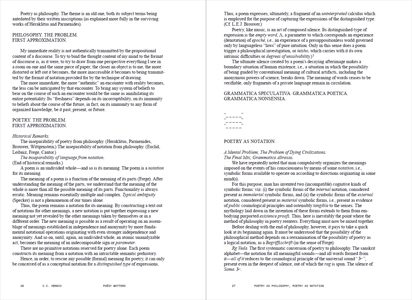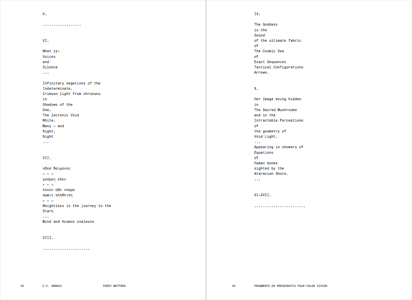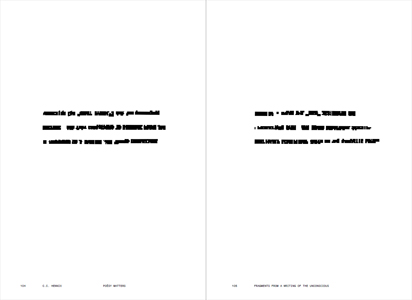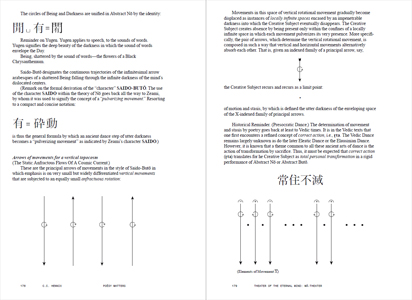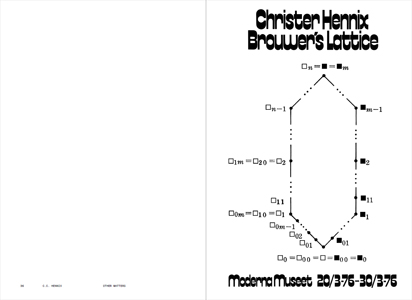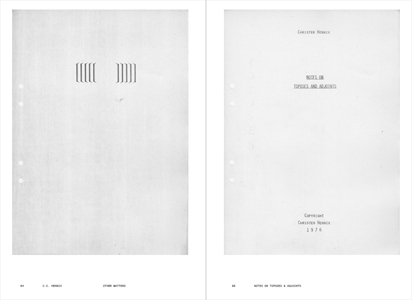The first comprehensive publication of the Swedish polymath Catherine Christer Hennix's written work in a two-volume set.
Volume one,
Poësy Matters, is divided into two sections: poetry and drama, with each section also containing pieces of commentary by Hennix or her longtime collaborator Henry Flynt. Volume two,
Other Matters, is divided into two sections: first, program notes and essays about a wide range of topics (including music, psychoanalysis, and mathematics), and second, a reproduction of Hennix's 1989 work
The Yellow Book. The first comprehensive publication of Hennix's written work,
Poësy Matters and Other Matters illustrates the singular depth and variety of her contributions to contemporary music, art, literature, and mathematics.
The texts in
Poësy Matters and Other Matters reflect Hennix's diverse training as well as her long-standing personal interests in Lacanian psychoanalysis and Japanese and Middle Eastern poetic forms, resulting in a rich, diffuse collection of writings that reveal one of the avant-garde's most implacable, not to mention overlooked, creative minds.
“Although it may at first confound, Hennix's work, given the deep engagement it requires and deserves, opens up a philosophical and spiritual bounty for her readers.
Poësy Matters/Other Matters constitutes a major historiographical contribution to our understanding of experimental music post–
John Cage”
— Canada Choate,
Artforum
“This tremendous collection will allow us, finally, to study the winding paths taken by Catherine Christer Hennix in five decades of virtually peerless exploration. As a roadmap, it promises nothing like answers. Instead, committed readers will find themselves edged further into a limitless space of multiplying questions: a fitting tribute to this bright magus and her luminous worlds.”
— Benjamin Piekut, Cornell University
“Hennix was among the first to connect constructive approaches in the foundations of mathematics to theories of tuning, minimalism, and art practices of the post-Cage avant-garde. These writings put forward a singular and highly individualistic agenda linking Brouwer's Creative Subject, Lacanian psychoanalysis, formal linguistics, categorical logic (and more) to the existence of an inexhaustible interior world.”
— Spencer Gerhardt, Composer and Mathematician
Best known as a composer, Catherine Christer Hennix (1948, Stockholm – 2023, Istanbul) has, throughout her fifty-plus-year career, produced innovative work in the fields of not just minimal and computer music, but psychoanalytic theory, intuitionist mathematics, poetry, and prose as well. Hennix was steeped in music and culture from a young age. Introduced by her mother to many of the era's iconic jazz musicians, she saw luminaries including
John Coltrane, Cecil Taylor, and
Eric Dolphy during their stints in Sweden, and took lessons from trumpeter Idrees Sulieman. Hennix was an early member of the Elektronmusikstudion (EMS), where she composed works for large mainframe computers in between her studies of biochemistry, linguistics, and mathematical logic. In 1968 she traveled to New York and quickly became immersed in the city's downtown scene through Something Else Press's
Dick Higgins and
Alison Knowles, who introduced her to figures such as
John Cage and
Walter De Maria. But most influential was her 1969 encounter with
La Monte Young, whose approach to music would shape her artistic trajectory. In turn, Young introduced her to Pandit Pran Nath, of whom she became a disciple, and Henry Flynt, with whom she maintained a close collaboration with until her death. In the early '70s, she returned to Sweden to found her own group inspired by the Theatre of Eternal Music, hoping to demonstrate how Young's musical concepts were general enough to allow musicians to take many paths through them.
During the second half of the '70s, Hennix was prolific as a musician, artist, and writer, although she struggled to find public outlets for her work with a few exceptions. In 1976 alone she co-organized the ten-day festival
Brouwer's Lattice at Stockholm's Moderna Museet, where she showcased the American composers Young, Terry Riley, and Terry Jennings alongside her own compositions, and presented the solo exhibition
Toposes & Adjoints: Survey of Abstract Concept Formations from Cantor to Lawvere, while pursuing a degree in mathematical logic at Uppsala University, writing poetry, and producing her first abstract Nō drama. Throughout this period, Hennix traveled between New York, Boston, Stockholm, and San Francisco—where she had a chance encounter with
Maryanne Amacher, who subsequently introduced her to the mathematician, poet, and activist Alexander Yessenin-Volpin, a meeting that would prove significant. Taken by Yessenin-Volpin's deep interest in Brouwer, Hennix became his primary student and eventually his research partner.
Hennix relocated to New York in 1978 to serve as a professor of mathematics and computer science at SUNY New Paltz, and later became an affiliate of the Massachusetts Institute of Technology's Artificial Intelligence Laboratory. While her position in upstate New York lasted for a single year, she collaborated with local artists and figures such as poet Charles Stein (who was leading informal seminars under the name The Rhinebeck Institute) and guitarist Arthur Rhames, and continued to be a key interlocutor to Flynt, recording with him as the Dharma Warriors. At the end of the '80s, she returned to Europe, first to Sweden and later to Amsterdam with her girlfriend, photographer Lena Tuzzolino, whom she met through participation in a group show at the Museum Fodor. While in the Netherlands, Hennix studied Lacanian psychoanalysis, and dedicated herself to creating visual arts, writing Nō works, playing drums, and conducting mathematics research at the University of Amsterdam's Institute for Logic, Language, and Computation. She was given the Centenary Prize Fellow Award by the Clay Mathematics Institute in 2000 for a paper coauthored with Yessenin-Volpin.
For much of her life, Hennix was an enigmatic figure in musical minimalism, primarily known for her "billowing cloud" study
The Electronic Harpsichord (1976). Her resurgence and later period of artistic activity can in many ways be credited to the advocacy of Henry Flynt, who would present the piece at tape concerts throughout the '70s and '80s and maintained a voluminous correspondence with her throughout. In 2003, Hennix returned to producing computer-generated sound works, initiating a productive two-decade run. After a long hiatus from leading ensembles, she formed the Chora(s)san Time-Court Mirage in 2005 after meeting the trombonist Hilary Jeffery, and later led the just intonation group the Kamigaku Ensemble. She toured internationally, released several archival recordings, circulated her poetic and theoretical writing, and exhibited her artwork in surveys such as
Traversée du Fantasme at Stedelijk Museum, Amsterdam, and
Thresholds of Perception at Empty Gallery, Hong Kong, in 2018.
While a student of Pran Nath, Hennix was introduced to Sufism—first in the Chishti Order, and later taking hand with Sheikha Fariha in the Nur Ashki Jerrahi Order—and has been dedicated to its practice ever since, integrating the devotional dimensions of Islam and Sufism into all of her work with poetry and sound. Hennix formally converted to Islam before relocating to Istanbul, where she spent the final years of her life in a wondrous immersion in the call to prayer, the sound of the One.


